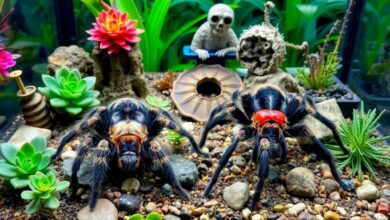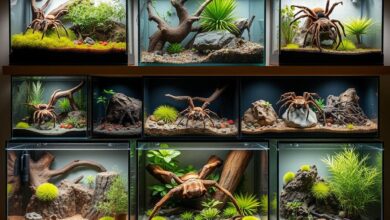Use of live and artificial plants in the terrarium and their benefits
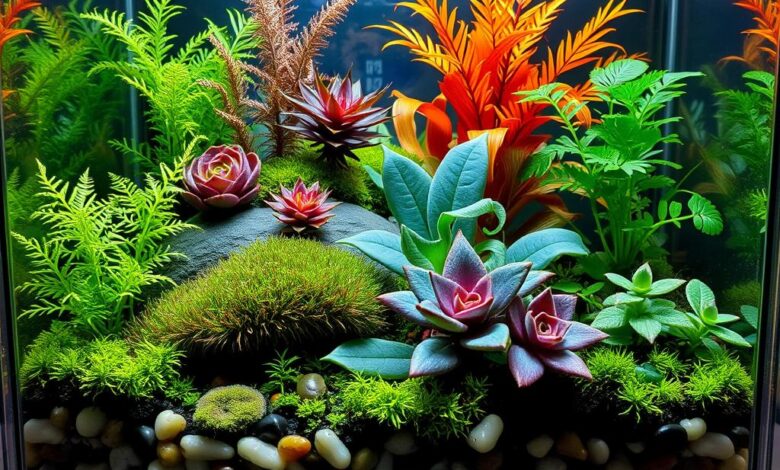
Terrariums are like mini indoor gardens that can hold live and artificial plants. They are easy to take care of and look great. They also help control humidity and let you grow plants indoors.
By making your own botanical compositions and miniature landscapes, you can bring nature inside. This lets you enjoy the beauty of nature right in your home.
You can choose between live plants or artificial plants for your terrarium. They’re perfect for anyone who loves terrarium gardening. These closed ecosystems keep the right amount of moisture, light, and temperature. So, your low-maintenance plants will do well with little work from you.
Start your journey with terrariums and see how they can change your indoor gardens. They turn your space into a peaceful, nature-filled area. This connects you more closely with the natural world.
What is a Terrarium?
A terrarium is a small indoor garden inside a clear container. It has a long history, starting in the Victorian era. People loved them for their beauty and how they kept plants alive indoors. There are two main types: closed and open terrariums, each with its own care needs.
Definition and Origins
The word “terrarium” comes from “terra,” meaning earth. These small gardens are self-sustaining and let plants grow indoors. They started in the 19th century with British botanist Nathaniel Bagshaw Ward. He found plants could grow in sealed glass containers by accident.
Types of Terrariums
- Closed Terrariums: These are sealed systems that make their own water cycle. They need little care because the moisture recycles naturally.
- Open Terrariums: These have more interaction with the outside world. They need more water and care to keep plants healthy.
Terrariums are a great way to add nature to your home. You can choose between the easy-care closed terrariums or the open ones you can customize. Either way, these mini gardens are sure to amaze and please.
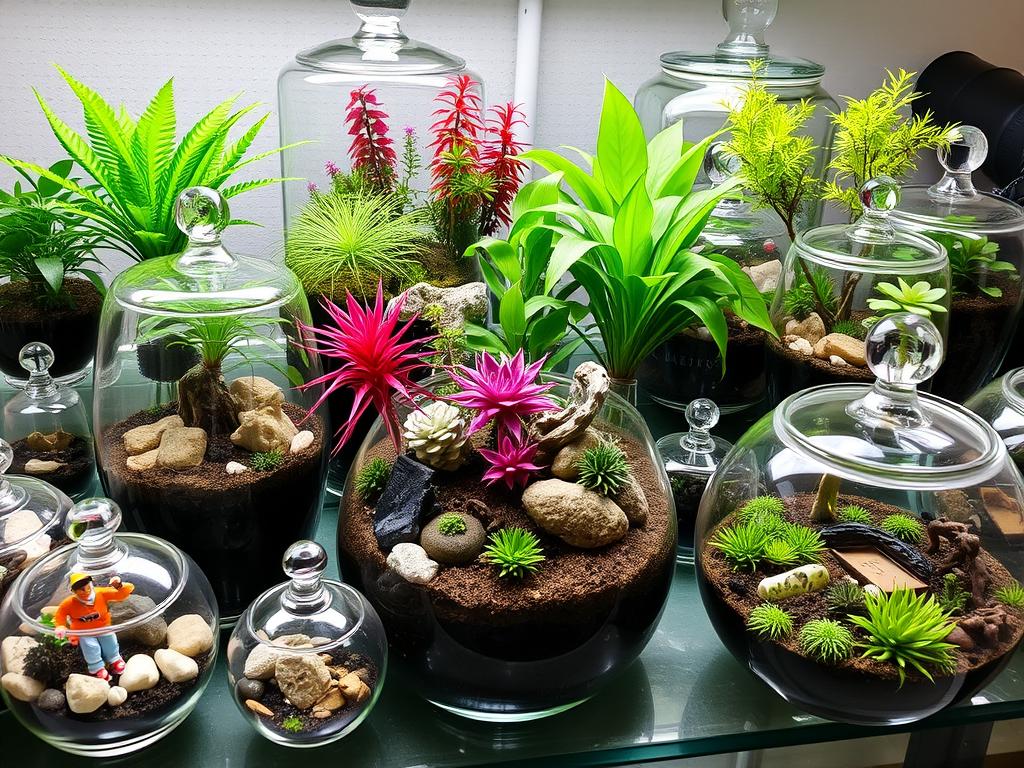
Benefits of Terrarium Gardening
Terrarium gardening is great for both indoor gardening fans and beginners. It’s easy to care for and looks beautiful. These gardens are perfect for anyone who loves to garden.
Low Maintenance
One big plus of terrarium gardening is how little work it takes. You only need to water them once or twice a month. This makes them perfect for people who are always busy or new to gardening indoors.
The closed environment keeps moisture in. This means plants get enough water without needing constant care. It’s a great way for plants to grow well with little help from you.
Aesthetic Appeal
Terrariums look amazing in any room. You can pick and arrange plants, soil, and decorations to make beautiful mini gardens. This lets you show off your creativity and make your space look better.
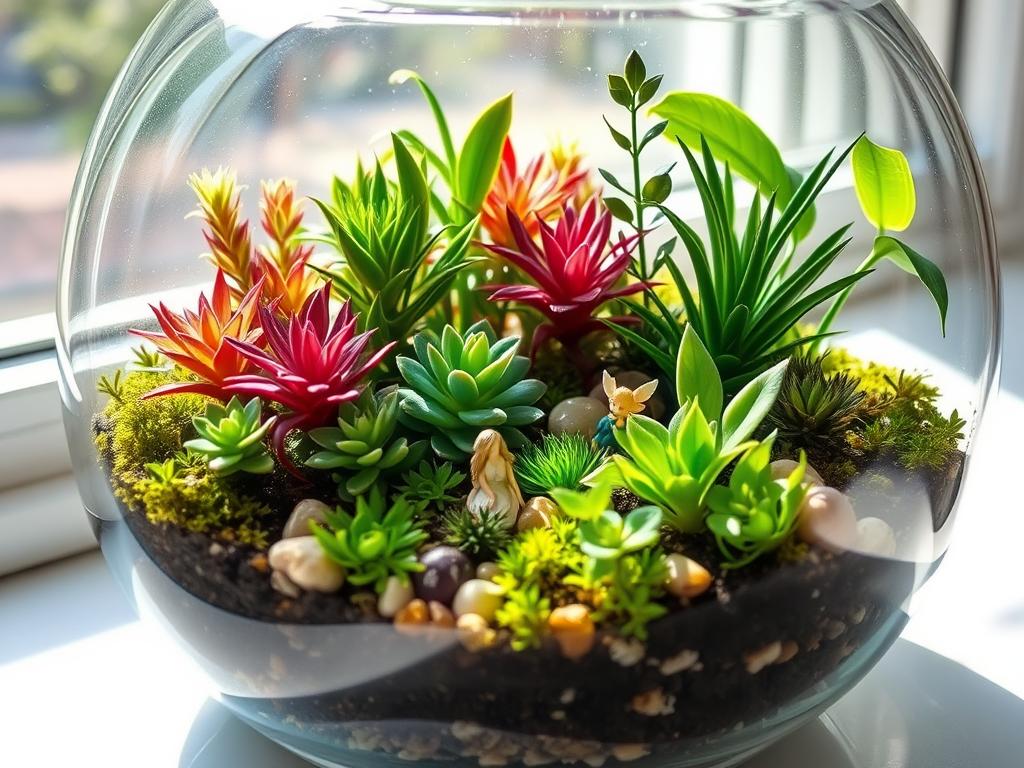
You can choose from lush green plants or go for a more fun, artificial plant terrarium. These gardens are eye-catching. They can be the main attraction, bring nature inside, and make you feel calm and happy.
Choosing the Right Plants for Your Terrarium
Choosing the right plants is key to a successful terrarium. Think about light needs, humidity, and how each plant grows. Pick plants that love low light, high humidity, or succulent terrarium plants for your terrarium.
Pothos, philodendrons, and ferns are great for low light. They look lush and fit well in terrariums. Humidity-loving plants like bromeliads, orchids, and air plants also do well. They keep your terrarium moist and look beautiful.
For color, add African violets, begonias, or mini succulents. These plants brighten up your terrarium and love its special environment.
| Plant Type | Light Requirement | Humidity Preference |
|---|---|---|
| Pothos | Low to medium | Moderate to high |
| Philodendron | Low to medium | Moderate to high |
| Ferns | Low to medium | High |
| Bromeliads | Medium to high | High |
| Orchids | Medium to high | High |
| Air Plants | Medium to high | High |
| African Violets | Medium to high | Moderate to high |
| Begonias | Medium to high | Moderate to high |
| Succulents | High | Low |
Choosing the right terrarium plant selection makes your terrarium beautiful and easy to care for. It brings natural beauty to your space.
Plants in Terrariums
Both live and artificial plants are key in making terrariums look great. Live terrarium plants like succulents, ferns, and mosses create a real ecosystem. They add beauty and help keep the terrarium healthy.
Live Plants for Terrariums
Adding live terrarium plants brings nature inside. Succulents are popular for their shapes and colors. Moss terrarium plants make the space look lush, and fern terrarium plants add a light, airy feel.
Artificial Plants for Terrariums
If you want something easy to take care of, try artificial terrarium plants. They look real and last a long time. You can find artificial moss terrarium plants and artificial succulent terrarium plants to match your style.
| Live Terrarium Plants | Artificial Terrarium Plants |
|---|---|
| Provide a natural, living ecosystem | Offer a low-maintenance, long-lasting option |
| Require regular care and maintenance | Require minimal to no maintenance |
| Contribute to the overall health and balance of the terrarium | Can still create a visually appealing miniature landscape |
Choosing live terrarium plants or artificial terrarium plants both make your terrarium special. They turn your space into a beautiful, easy-care display.
Setting Up a Live Plant Terrarium
Creating a live plant terrarium needs careful thought on the containers and substrates you pick. Also, think about the lighting and ventilation. With the right choices, you can make a balanced, self-sustaining closed ecosystem. This lets your plants flourish.
Terrarium Containers and Substrates
For terrarium containers, choose a clear, sealed, or partly sealed container. This lets in plenty of light and air. You can use a glass jar, an old aquarium, or a custom-made box. The terrarium substrate should drain well and feed your plants. A mix of potting soil, sand, and small rocks or pebbles works well.
Lighting and Ventilation for the Terrarium
Good terrarium lighting is key for your plants’ health and growth. You might use a special terrarium lamp, a window spot, or both. It’s also important to have terrarium ventilation. Make sure there are openings or vents for air to move around and prevent bad air.
By picking the right terrarium containers, substrates, lighting, and ventilation, you can make a live plant terrarium that thrives. It will show off the beauty of a self-sustaining closed ecosystem.
Maintaining Your Live Plant Terrarium
Keeping a live plant terrarium alive and thriving is a delicate task. It’s all about the right balance of care and attention. You need to water, prune, and control pests to keep your mini garden healthy.
Watering and Pruning
Watering is key in terrarium care. But, don’t overdo it. Only water when the top inch or two of soil feels dry. Mist the plants lightly a few times a week to keep humidity right.
Pruning keeps your terrarium plants in shape and stops them from getting too big. Use sharp scissors to cut off dead or dying leaves and stems. Prune plants that are getting too crowded to keep your terrarium looking great.
Pest Control and Troubleshooting
Even with the best care, pests or diseases can show up in your terrarium. Watch for pests like aphids or mealybugs and deal with them fast. Use a safe, natural pest control method. If plants start to look sick or wilt, check why. It could be too much water, not enough light, or not enough nutrients.
By watching your terrarium plants closely and fixing problems quickly, you can keep them healthy and bright. Regular care and troubleshooting will help your mini garden thrive for many years.
Terrarium plant careis crucial for a live plant terrarium. Paying attention to watering, pruning, pest control, and troubleshooting keeps your plants healthy. This ensures your mini garden does well.
Creating an Artificial Plant Terrarium
Creating a beautiful terrarium doesn’t need live plants. Artificial plant terrariums are a great choice for those who want a beautiful, easy-care miniature landscape. When picking artificial terrarium plants, choose ones that look and feel like real plants. This makes the terrarium look more natural.
Selecting Realistic Artificial Plants
Invest in realistic fake plants that look like the real thing. Find artificial plants, succulents, and tiny trees with lots of details and colors. These artificial terrarium plants make your terrarium look full and alive without the work of real plants.
Designing Your Miniature Landscape
- Arrange the artificial terrarium plants in a way that looks good, adding depth and dimension to the terrarium design.
- Add things like decorative stones, driftwood, or small figures to make the miniature landscape more interesting.
- Try different plant sizes, textures, and colors to make a beautiful and engaging low-maintenance terrarium.
By picking realistic fake plants and designing a thoughtful miniature landscape, you can make an artificial plant terrarium that feels like nature. It’s easy to take care of and lasts a long time.
Incorporating Natural Elements
To make your terrarium look more real, add things like rocks, pebbles, moss, or driftwood. These natural terrarium elements make the inside look more like a real miniature landscape. They also make your terrarium more interesting and true to nature.
Rocks and pebbles can look like real ground, giving your terrarium depth and stability. Moss brings a green, lush feel, like a forest or a damp spot. Driftwood adds a unique look, bringing a rustic feel and depth to your terrarium.
Choosing and placing these natural terrarium elements wisely can turn your terrarium into a beautiful mini-world. The mix of textures, colors, and shapes creates a stunning look. Your terrarium decorations and terrarium accessories will be the highlight of your room.


